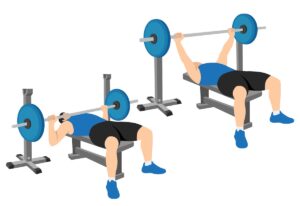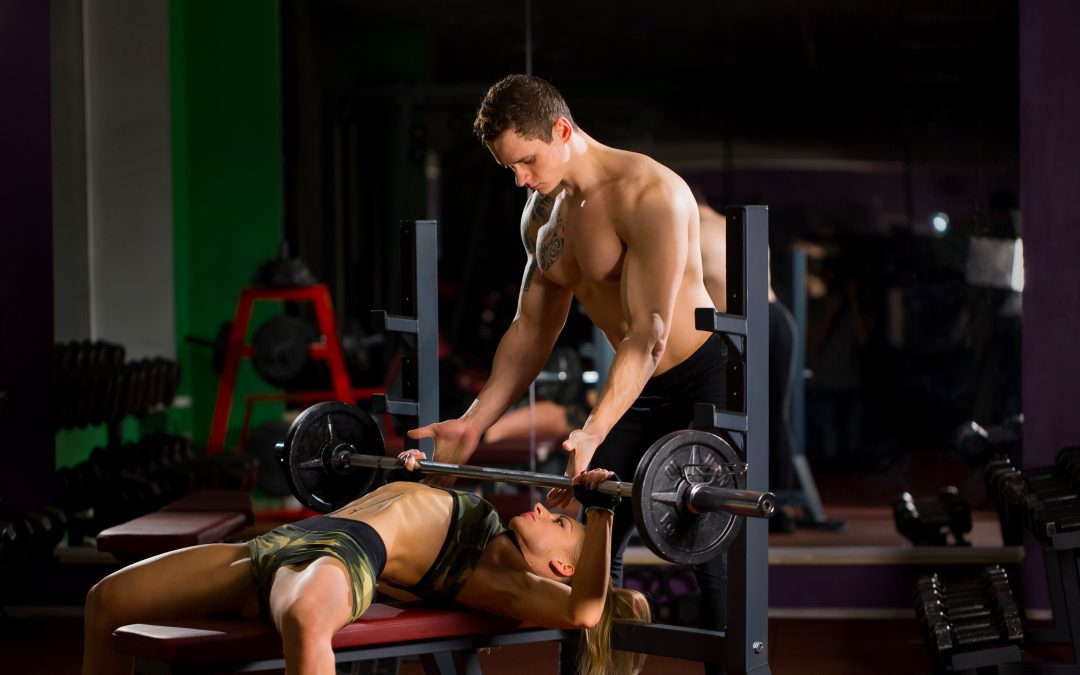If I had to choose one of the top five exercises to develop a great physique and get stronger, the bench press would be one of them. This is a classic chest exercise. The bench press is a compound exercise that targets several muscles in the upper body and has numerous benefits.
Below we’ll look deeper into bench presses and we’ll cover the following:
- Muscles involved in bench presses
- Benefits associated with bench presses
- How to do the bench press properly
- Common mistakes when performing bench presses
- Video on how to do bench presses
- Exercises to complete your chest workout
What Muscles Do Bench Presses Work?
Primary Muscles:
- Chest Muscles: These are the pectorals, which are divided into the pectoralis major and pectoralis minor. The pectoralis major is the larger one, a fan-shaped muscle comprising most of the chest wall. It keeps your arms attached to your body and is involved in adduction and internal rotation of the arm on the shoulder joint, as well as flapping, pressing, and lifting movements. The pectoralis minor is smaller and flatter. This one lies underneath the pectoralis major and is involved in shoulder functioning.
Secondary Muscles:
- Triceps Brachii: The name triceps comes from the fact that these muscles are composed of three muscle strands (the long, medial, and lateral heads). It specifically targets the long head of the tricep. The triceps are involved in forearm and elbow extension, helping extend or straighten the elbow. They are also involved in shoulder adduction and extension, helping pull the arms down. Additionally, the triceps help to stabilize the shoulder joint. Close grip presses target all three heads of the muscle, especially the long head.
- Deltoids: These are the main shoulder muscles. The anterior deltoid flexes and medially rotates the arm, the lateral deltoid abducts the arm, and the posterior deltoid extends and laterally rotates the arm. The anterior deltoids are very active in close-grip dumbbell presses and much more in an incline position.
- Rotator Cuff: A group of muscles and tendons that surround the shoulder joint (supraspinatus, infraspinatus, teres minor, and subscapularis) and are responsible for stabilizing your shoulder joint.
- Serratus Anterior: Muscles on the upper sides of the torso that wrap the rib cage. The main part lies deep under the scapula and the pectoral muscles – in between the pectoralis major and latissimus dorsi muscles. They rotate and draw the scapula anterolaterally.
- Coracobrachialis: Long muscles of the anterior compartment of the arm – deep muscles of the chest and front of the arm, with the boundaries of the axilla. They extend from the coracoid process of the scapula to the shaft of the humerus. Their function is flexion and adduction of the arm at the shoulder joint.
- Trapezius: These diamond-shaped muscles extend from the top of the neck to the shoulder and down toward the mid-back. They attach to the skull, vertebral column, and shoulder girdle. They are involved in the movements of the shoulder girdle.
Bench Press Benefits
After learning the muscles involved in bench presses, let’s look at the vast benefits associated with the exercise:
- Calorie Burner: The bench press is a multi-joint exercise encompassing many muscles, which helps you burn more calories and consequently more body fat.
- Aesthetics: Bench pressing molds your upper body nicely – for males and females. Your chest gets higher and your shoulders and arms develop a great shape.
- Time Efficient: The bench press is a compound move, helping you work several muscles at the same time, and making you more productive at the gym.
- Strength: The bench press not only makes your chest muscles stronger but your whole upper body. The more weight you bench press, the more weight you can most likely shoulder press, and lift during tricep exercises. At the same time, you will become better at performing push-ups.
- Healthier Bones: Chest presses like other resistance training exercises support bone health and help prevent osteoporosis.
- Increased Power: Power is your capability to exert force, over a given distance as fast as possible. As your upper body becomes stronger performing chest presses, you can increase your power by performing each repetition more intensely.
- Simplicity: There is not a lot of equipment involved. You just need a bench and a barbell (you can even perform presses with a set of dumbbells – dumbbell chest press– or even with resistance bands – band chest press). Plus, anyone can do them. You do not need to be an expert lifter to do chest presses or be of a specific age or sex.
How to do Bench Presses

- Lie on the bench. Position yourself far enough under the bar so it’s easy to unrack the bar but not so far under that you hit the pegs when you are pressing up.
- Plant your feet flat on the floor and relatively wide apart. It’s best to have your feet on the floor rather than placing them on the bench, so you are more stable.
- You can keep your butt, shoulders, and head flat on the bench with a neutral spine or squeeze your shoulder blades together to stay centered and keep your back tight and arched.
- Grasp the barbell tightly using an overhand grip, placing your thumbs on the outside of your closed fist.
- Your arms are generally slightly wider than shoulder-width apart. If you have longer arms and/or want to push greater weight, you’ll need to grip the bar wider. A narrower grip is better if you have shorter arms. Either way, don’t exaggerate the grip.
- Your arms should be about 50 degrees to the body so you can grab the bar and bring it to a 90-degree angle.
- Remove the barbell from the rack.
- As you inhale, lower the bar slowly so it is just above your chest, at the nipple line.
- As you exhale, press the bar above your chest, extending your arms without locking them on the top. Don’t watch the bar—focus on the ceiling.
- Repeat the movement for 8 to 12 repetitions and 3 sets. If you want to work on power and strength, repeat up to 5 times.
- Once you’ve finished your reps, move the bar backward gradually until you feel the rack uprights, then lower the bar and rack it.
? Start using a weight that you can comfortably lift for 12 reps and three sets. Once you perform this exercise safely and with proper form, begin to add weight. You can add 2.5 pounds to each side of the bar (5 pounds total addition per week) each week.
? If you have shoulder injuries, you should avoid this exercise. If you experience any sharp pain during the bench press, stop the exercise immediately.
Bench Press Mistakes
- Moving the bar over the head or neck: The path of the bar shouldn’t be over the head/neck area when racking, unracking, or throughout the exercise. This is unsafe and dangerous. Plus, moving the weight toward the head, not keeping it at chest level, removes the emphasis on the chest muscles.
- Improper grip: Grabbing the bar too wide keeps your elbows too flared out, risking injury to your pectoral muscles. Grabbing the bar too close targets the tricep area more so you would be performing close grip presses. Your grip on the bar should normally be slightly wider than shoulder-width apart so your elbow joints and forearms are in a perpendicular plane.
- Incorrect thumb position: Avoid placing the thumbs behind the bar or locked beneath the fingers. Your hand grip should be overhand with the thumbs placed under the bar and across the top of the fingers. It’s much safer.
- Locking elbows suddenly: Avoid locking the elbows out explosively or locking them at the top. It’s not good for the elbow or shoulder joints.
- Pressing your head into the bench: Pushing your head into the bench to help move the weight up stresses the neck muscles instead of the intended pectorals. Keep your head flat on the bench and soft.
- Lifting your butt: Elevating the buttocks during the movement strains the lower back. Your butt should remain flat on the bench while pressing.
Bench Press Video
Chest Workout
You can complete your chest workout by performing the following exercises:
As you can see the bench press is a wonderful chest exercise. It offers tremendous benefits associated with hypertrophy, strength, endurance, and aesthetics. Now that you know how to properly perform bench presses, you can avoid the most common mistakes and enjoy their benefits. Remember, whether you want to lose weight, tone your body, or gain strength or size, all muscles must be trained.
Lift, Burn more Fat, Get Stronger, and Live Healthier!
To a Fitter Healthier You,
The Fitness Wellness Mentor




